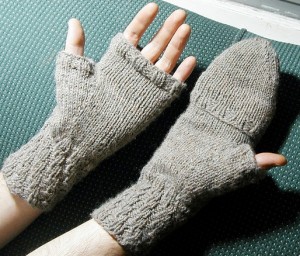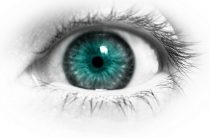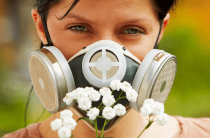Cold allergies provide a lot of discomfort. People who suffer from this disease cannot go outside in freezing weather. For many people, the skin on the nose, hands begins to redden, and the eyes are very watery. Having determined the main causes of cold allergies, it will be possible to start treating the disease.
A similar reaction can be caused by such an external stimulus as cold. When the temperature drops, the metabolism in the cells slows down, the body is not able to cope with these changes, and the production of histamine begins. due to the influence of the cold. The skin begins to redden and peel off. Most often, exposed areas of the skin - the face, neck, hands - are affected by cold allergies.
 The causes of cold allergies are the features of the winter season. Physicians register many manifestations of cold allergies in the second half of winter. This is due to the fact that the body at the end of winter is weakened, it lacks minerals and vitamins. Regular respiratory diseases contribute to a decrease in immune defense, and as a result, the body's resistance to cold.
The causes of cold allergies are the features of the winter season. Physicians register many manifestations of cold allergies in the second half of winter. This is due to the fact that the body at the end of winter is weakened, it lacks minerals and vitamins. Regular respiratory diseases contribute to a decrease in immune defense, and as a result, the body's resistance to cold.
If a person had complex somatic diseases, diseases of the gastrointestinal tract, a violation of the enzyme function, the resistance of his body to various allergens decreases.
Reduced immunity also occurs after surgery, pregnancy, childbirth. Many infectious diseases can trigger allergies.
An allergy to cold can develop due to reasons such as:
- prolonged use of antibiotics;
- chronic diseases: tonsillitis, sinusitis, sinusitis, caries;
- helminth infection;
- problems with the digestive tract;
- diseases of the kidneys, liver, pancreas, dysbacteriosis;
- malfunctions of the endocrine system;
- colds, cancer and even stress.
Since the "circle of risk" is large enough, the body's reactions to cold cannot be ignored. After all, this can lead to serious problems. The most susceptible to cold allergies are those who:
- One or both parents are allergic, or allergic reactions occur in relatives;
- There is an allergy to dust, pollen, food and other substances.
It is worth noting that not only frost can cause an allergic reaction. Also, drafts, a quick change in temperature (from high to low), swimming in low temperature water, or the moment you exit the water can provoke it.
The main reason that leads to an allergy to cold is a reduced immune system. The weakening of the immune defense occurs due to the presence of the following diseases in a person:
- infectious processes;
- chronic diseases of the gastrointestinal tract;
- parasitic diseases (worm infestations, giardiasis, chlamydia), which are capable of
- provoke chronic intoxication of the body;
- poorly sanitized oral cavity (caries, periodontal disease);
- chronic diseases of the throat;
- nervous breakdowns.
The main symptomatology of allergy to cold
The most common manifestation is cold urticaria, which occurs on unprotected areas of the skin. The face, neck, and hands are especially susceptible. Its features are:
- severe itching and burning sensation;
- swelling, not only of the skin, but also of the mucous membranes;
- painful sensations;
- skin redness;
- bouts of sneezing and coughing;
- the occurrence of blisters and seals on the skin.
Blisters can combine with each other and cover almost the entire body that is in contact with the cold.
| With cold dermatitis, the skin itchs and turns red, and also peels off. |
| Cold rhinitis is characterized by a runny nose with mucus secretions, which completely disappears when a person is in a warm room. |
| With cold conjunctivitis, the patient develops cutting pain in the eyes and lacrimation, which disappear with the onset of warm weather. |
| Cold cheilitis - swelling of the lips that appears after the patient eats ice cream. Most often, the lower lip becomes inflamed, covered with small scales, or ulcers. |
| Cold asthma manifests itself in shortness of breath, suffocation from cold air, frost. Such symptoms occur due to a sharp narrowing of the respiratory tract. |
One of the rare forms of allergies is familial cold urticaria. This hereditary pathology is characterized not by instant manifestations, but by symptoms that occur a couple of hours after contact with cold. There were cases when the allergy manifested itself a day after contact with the allergen. The disease is characterized by a maculopapular rash.
The main difference between cold allergies and other types is the disappearance of all symptoms after the cold ceases to act on a person. Sometimes the disappearance of symptoms occurs slowly gradually, and sometimes rapidly.
There are times when an allergy to cold is perceived as a common cold or a viral disease. A distinctive feature of allergies is the absence of high body temperature, and the presence of edema of the larynx and mucous membranes. And they also pay attention to a rash on the skin, which is not typical of SARS.
Symptoms of allergy to cold on the hands
The most common site of injury is the hands. Less blood enters the hand, especially when a person walks down the street with his hands down. The exposed skin of the hands is an easy target for exposure to cold. The situation is aggravated by the fact that hands are often washed. In the process, not only bacteria are washed off from them, but also the protective layer. For this reason, the skin on the hands often dry out, and become more prone to allergic manifestations.
Cold allergies on the hands are accompanied by red rashes that are inherent in allergic dermatitis. The skin becomes dry and irritated. The affected areas of the skin are very itchy, and they feel a burning sensation. on the back of the hand , as the epidermis on them quickly exfoliates, the recovery of inflamed areas is slow.
Cold allergy in exposed areas of the skin can be confused with dermatitis. It is characterized by small rashes with severe itching. The skin of the cheeks and forehead turn red and swell. Strengthening of symptoms occurs after each exit to the street in frosty weather. If you scratch the skin, you can bring the infection, and healing will be longer.
Other parts of the body are less susceptible to manifestations of allergic dermatitis, the only exceptions are occupational features or accidental frostbite.
Allergies can look like cold rhinitis. In this situation, the nasal mucosa is negatively affected, characteristic symptoms of inflammation of the nasopharynx begin to appear.
Cold conjunctivitis is characterized by tearing and inflammation of the mucous membranes of the eyes.
An allergy to cold air is accompanied by difficulty breathing, prolonged coughing spells, and endless lung diseases in winter.
cold allergy treatment
Cold allergy is treated on an outpatient basis, very severe forms in a hospital. The main actions of specialists include:
- Restorative therapy. Patients should take vitamins A and E for two weeks. The use of such components helps to heal the skin, restore their elasticity. After the reception of vitamin complexes for a long time, Duovita, Complevit, Centrum begins. The doctor may additionally prescribe immunomodulators, like Immunal, Likopid. Also, take calcium supplements. This helps to strengthen the vascular walls, and allergens cannot spread to neighboring areas.
- Means of local action. The patient is prescribed ointments with anti-inflammatory and wound healing properties. Such as Solcoseryl, Celestoderm, Triderm. If an infection is introduced into the affected area of \u200b\u200bthe skin, an additional antibacterial ointment should be used.
- Antiallergic antihistamine drugs. They are able to reduce the reaction of the body and stop the inflammatory process. In such cases, it is necessary to use Phencarol, Suprastin, in severe cases - Zirtek, Lomilan.
- The reasons for the decrease in immunity are determined. A doctor must conduct a study, and latent forms of the disease are revealed. Allergies are often associated with pathologies of the digestive organs.
For successful treatment of allergy to cold, it is necessary to observe the following rules:
- Do not wash your hands in cold water, do not eat too cold foods, do not take a cold bath or shower.
- Before going out into the cold, it is necessary to apply oily creams to exposed skin.
- Take antihistamines before going out to help relieve allergic symptoms. Taking antihistamines can help relieve allergy symptoms. These funds are constantly accepted. Stopping them, even for a short period of time, can contribute to the return of symptoms.
- Relief of the symptoms of cold allergies can occur if a person hardens - doing rubdowns, dousing with warm water, the temperature of which should drop from thirty-seven to ten degrees. Once a week, you need to lower the water temperature by one degree. This method can be used only for those people whose allergy symptoms are not pronounced. But in severe cases, with a rapid course of an allergic reaction, it is impossible to harden, because in this way anaphylactic shock can develop.
Another effective method of eliminating allergies to cold is autolymphocytotherapy. The essence of the procedure is the introduction of lymphocytes, which are isolated from the patient's blood. Repeat this procedure eight times, every two days. The method is highly safe and highly effective.
Complications of cold allergy
Unpleasant sensations from allergies, which can provoke itching, redness, rashes, can worsen and become more severe.
Perhaps the development of anaphylactic shock - a systemic reaction, which is accompanied by an instant drop in pressure, a violation of vascular permeability. Symptoms of this complication occur instantly, so you need to immediately call for help. Delayed medical care can lead to death.
Laryngeal edema (Quincke) develops after a person has eaten or drunk cold food or water.
Preventive measures for cold allergies
There are cases when cold allergy is not a separate disease, but only a symptom of another pathology. Therefore, you need to carefully examine to identify "weak" places that exhaust the immune system. It is necessary to properly treat the immune system in order to achieve a period of calm.
If a person has a cold allergy, they should avoid contact with potential allergens.
Some people believe that drinking alcohol is good for cold allergies. In fact, drinking alcohol not only does not have any positive effect, but also harms.
A person who suffers from an allergy to cold is recommended to carry a thermos with hot drinks. Their use will even out the body temperature, so that the symptoms will gradually disappear.
It is difficult to completely recover from an allergy to cold, but there is a chance to minimize all its symptoms by adhering to the following simple rules:
-
 Choose clothes according to the temperature outside. It is necessary to protect the legs with socks, tights, wrap the neck with a warm scarf, put on warm mittens on the hands. It is advisable to give preference to cotton or linen clothes, because wool or synthetics will have a negative effect. It is better to protect your head with a hood, which will become an indispensable assistant in case of wind or frost;
Choose clothes according to the temperature outside. It is necessary to protect the legs with socks, tights, wrap the neck with a warm scarf, put on warm mittens on the hands. It is advisable to give preference to cotton or linen clothes, because wool or synthetics will have a negative effect. It is better to protect your head with a hood, which will become an indispensable assistant in case of wind or frost; - Before going out into the cold (20 minutes before), spread the skin of the face and hands with a fat cream, and lips with hygienic lipstick. You can also use a regular cream, just make sure that it is not moisturizing. After all, moisturized skin becomes an easy target for frost and strong winds;
- You need to try to breathe not through your mouth, but through your nose. When leaving the house, it is better to take shallow ordinary breaths, and then switch to a normal breathing rhythm.
-
 Adjust your diet in this way. So that it includes nuts, fatty fish, olive oil, foods that contain omega-3 fatty acids. It would also be a good idea to include badger fat in it, consuming it every day forty minutes before breakfast. Also, they can lubricate open areas of the skin. Applying it both inside and outside, a person strengthens his immunity, does not allow hitting a weakened body.
Adjust your diet in this way. So that it includes nuts, fatty fish, olive oil, foods that contain omega-3 fatty acids. It would also be a good idea to include badger fat in it, consuming it every day forty minutes before breakfast. Also, they can lubricate open areas of the skin. Applying it both inside and outside, a person strengthens his immunity, does not allow hitting a weakened body. - Before you go outside, it is recommended to drink a hot drink, but not a "hot" drink. After all, alcohol will not have a warming effect, but the opposite of it.
- The affected areas should be lubricated with aloe juice, or oil with vitamin E;
- In small quantities, consume coffee, cocoa, chocolate, citrus fruits, strawberries, pineapples, smoked and spicy foods;
- Carry out hardening. Just start it carefully and gradually.
Cold allergy in children
The skin of children is particularly sensitive, and therefore they react even to minor changes in the world around them. Cold contributes to the rapid irritation of the child's skin, because the immune system is not yet sufficiently formed to withstand external factors. Malfunctions in the immune system lead to an allergy to cold in a child.
To cure allergic diseases, you should consult a specialist. Also, it will not be superfluous to conduct a differential diagnosis with food allergies.
The best solution is not treatment, but prevention. In the assortment of the pharmacy there are many special creams, such as Frosty Cheeks, Rosy Cheeks. They are able to moisturize the skin and increase its resistance to various external factors.
Our consultant will be able to tell in more detail about the causes of cold allergies.















